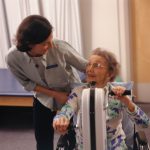 Ataxia is a neurological movement disorder that affects muscle coordination, disrupts balance and impairs walking. The effects of ataxia are due to damage caused to the cerebellum – a part of the brain that controls muscle coordination.
Ataxia is a neurological movement disorder that affects muscle coordination, disrupts balance and impairs walking. The effects of ataxia are due to damage caused to the cerebellum – a part of the brain that controls muscle coordination.
There are many different types of ataxia; over 40 types are inherited. Some types of ataxia include cerebellar ataxia – the dysfunction of the cerebellum, sensory ataxia – the loss of proprioception, which is the sense of neighboring parts of the body, and vestibular ataxia – a sudden unilateral case that can lead to vertigo, nausea and vomiting.
Types of ataxia
Advertisement
As mentioned, there are many types of ataxia with the above listed being general categories. More specific types of ataxia include:
 Friedreich’s ataxia: Common hereditary form of ataxia that affects one in every 50,000 people. This type can lead to problems with coordination, slurred or slow speech, dysphagia, abnormal curvature of the spine and total or partial vision loss, just to name a few. Symptoms can worsen over time and individuals with this form of ataxia tend to have shorter life spans.
Friedreich’s ataxia: Common hereditary form of ataxia that affects one in every 50,000 people. This type can lead to problems with coordination, slurred or slow speech, dysphagia, abnormal curvature of the spine and total or partial vision loss, just to name a few. Symptoms can worsen over time and individuals with this form of ataxia tend to have shorter life spans.
- Ataxia-telangiectasia: This is a rare hereditary form of ataxia affecting one in every 100,000 people. Symptoms may begin in childhood or develop over time. Some symptoms include difficulty walking, small spider-like clusters of blood vessels in the eyes, a weakened immune system, and an increased risk of cancer. Symptoms can worsen quickly and individuals with this form generally have short lifespans.
- Spinocerebellar ataxia: This type of ataxia does not begin until adulthood and can affect those over the age of 25. Symptoms may include problems with balance and coordination, slurred or slow speech, muscle stiffness and cramps and memory loss.
- Episodic ataxia: Individuals experience episodes of ataxia and between episodes they can function normally or have mild symptoms. Symptoms include problems with balance and coordination, slurred or slow speech, muscle spasms, involuntary eye movements and vertigo. Episodic ataxia can develop during the teenage years and symptom episodes can last for minutes or hours. Medication can be useful to control attacks.
Causes of ataxia
Ataxia is caused by damage to the brain, more specifically the cerebellum, which is known to control movement. Damage to the spinal cord and nerves can also lead to ataxia.
Damage to the cerebellum can occur due to injury, illness, or degeneration of the spinal cord due to faulty genes. Sometimes there is no clear cause for ataxia, thus deeming it idiopathic.
Ataxia can either be acquired of hereditary. Causes for acquired ataxia include:
 Severe head injury
Severe head injury- Bacterial brain infection
- Viral infection
- Stoppage of blood to the brain, i.e. stroke
- Cerebral palsy
- Multiple sclerosis
- Underactive thyroid
- Long-term alcohol misuse
- Vitamin B12 deficiency
- Certain toxic chemicals
- Certain medications
Hereditary ataxia is caused by a faulty gene, which can be passed on through autosomal recessive, where the faulty genes are from both parents or autosomal dominant, where the faulty gene comes from one parent and the mutation is strong.
Symptoms of ataxia
Depending on the type of ataxia a person has the symptoms may vary. Common symptoms of ataxia seen across many different types of the disorder include:
- Poor limb coordination
- Slurred, slow speech
- Swallowing difficulties
 Tremors
Tremors- Involuntary eye movements
- A foot with high arch
- Cold feet due to lack of activity
- Balance problems
- Walking problems
- Vision problems
- Hearing problems
- Depression
Treatment and therapies for ataxia
There is no current cure for ataxia, but treatment is available to help minimize symptoms and treat the underlying cause. A person with ataxia may require help from a treatment team that utilizes specialists from different areas, known as a multi-disciplinary team. Common members of the treatment team include a neurologist, ophthalmologist, urologist, cardiologist, physiotherapist, speech and language therapist, occupational therapist, social-worker, dietician and specialist neurology nurse.
 Treatment and therapies for those with ataxia involve the following:
Treatment and therapies for those with ataxia involve the following:
- Symptomatic treatment that works to treat symptoms
- Physiotherapy to prevent muscle spasms, weakness and improve flexibility and strength
- Speech and language therapy
- Nutritional advice, swallowing may become difficult limiting the types of foods patients can consume
- Occupational therapy to boost self-efficiency and independence
- Medications to treat symptoms such as sleeplessness, improve bladder function, treat erectile dysfunction, pain relievers, antidepressants and cognitive behavior therapy, and treating cardiomyopathy if it occurs
Treatment may also be based on the underlying cause, for example, if ataxia is caused due to a deficiency, restoring levels of the deficient vitamin may help. Treatment and therapy is very specific to the individual’s needs as they work closely with their team.
Related Reading:
Migraine headache may double risk of Bell’s palsy (facial paralysis)
Migraine headaches may double the risk of Bell’s palsy (facial paralysis). Bell’s palsy is a condition categorized by a sudden weakness in facial muscles. This muscle weakness can cause half of your face to droop and make your smile look one-sided or as if one eye is nearly closed. Continue reading…
Advertisement
Focal epilepsy seizures linked to three brain regions, found with functional MRI
Focal epilepsy seizures link to abnormalities in three brain regions was found using function MRI (fMRI). The latest study found that the three brain regions found with fMRI are the main areas where focal epilepsy seizures originate. The authors wrote, “These brain areas may represent key regional network properties underlying focal epilepsy.” Continue reading…
Sources:
http://www.medicalnewstoday.com/articles
http://www.sciencedaily.com/releases
http://www.nhs.uk/Conditions/Ataxia/Pages/Symptoms
http://www.nhs.uk/Conditions/Ataxia/Pages/Causes
http://www.news-medical.net/health/Ataxia-Treatment
http://www.medicalnewstoday.com/articles
http://www.nhs.uk/Conditions/Ataxia/Pages/Treatment
